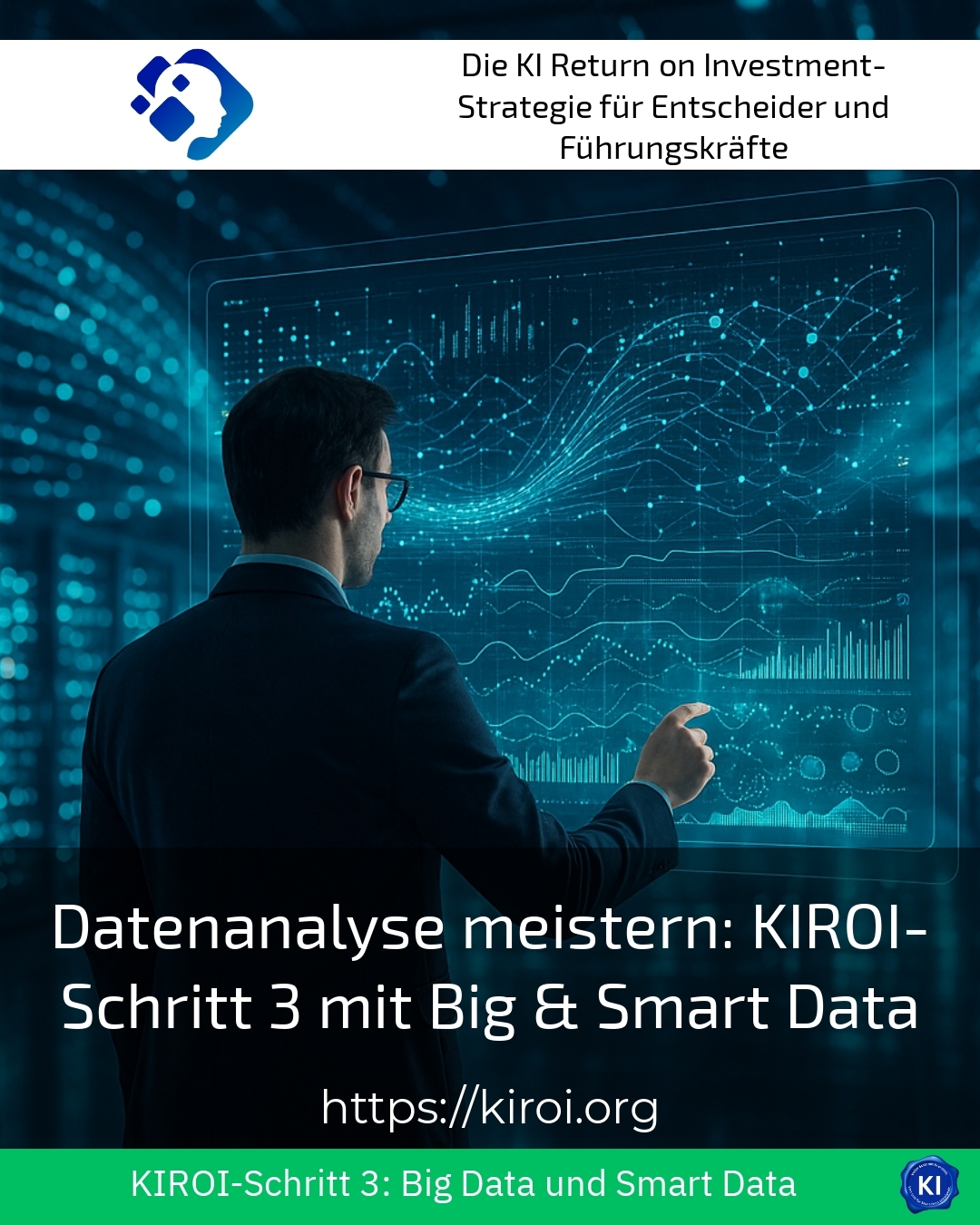The Data analysis is crucial today in order to gain business impulses from the sheer unmanageable amount of information. Large volumes of data in particular are of little use without structured analysis. As part of KIROI step 3, transruptions coaching supports companies in transforming big data into smart data in a targeted manner. This creates valuable knowledge for well-founded decisions and sustainable process improvements.
Understanding data analysis: From Big Data to Smart Data
Big data stands for huge, often unstructured collections of data from various sources such as machines, customer interactions or social media. These endless amounts of data can hardly be utilised efficiently using traditional methods. In contrast, smart data means that this information is processed and analysed in a targeted manner so that it provides relevant and actionable insights for decision-making.
A typical example from industry is the manufacture of products: Sensor data records thousands of production parameters. However, pure big data storage is hardly able to provide any insights. With the help of intelligent Data analysis-methods, this data is checked for quality, consolidated and patterns - such as recurring deviations or signs of failure - are uncovered. This enables predictive maintenance to be initiated and unnecessary downtimes to be avoided.
In the healthcare sector, smart data analyses support the development of individualised therapies. Patient data from various sources is collated in a structured manner in order to identify trends and treatment approaches. This makes complex data volumes understandable and usable for medical professionals.
In marketing, companies use data analyses to identify consumer behaviour and develop individual campaigns. For example, the evaluation of social networks, purchasing behaviour and web analyses can be used to create personalised and targeted offers that increase customer satisfaction.
KIROI step 3: The structured process of data analysis
The third step of the KIROI approach provides training in dealing with the volume of data in particular, which is also checked for quality and relevance. The focus here is on several phases:
- Data consolidation: Data from various systems and sources is merged. In this way, companies avoid data silos and ensure a clear basis.
- Quality check: Inaccurate, missing or outdated data is corrected. Only clean data forms the basis for reliable analyses.
- Identification of relevant patterns: Using methods such as machine learning or data mining, correlations and patterns that were previously hidden are recognised.
A process for the early detection of quality deviations was implemented at an industrial customer as part of a transruption coaching project. This analysis led to a significant reduction in rejects and saved considerable costs.
Also at a financial services provider, the targeted Data analysis improved risk assessment of customer data. Based on this, credit decisions could be made faster and more reliably, while at the same time increasing customer satisfaction.
In the logistics area, the supply chain was optimised with the help of a structured smart data analysis. This involved linking data from warehousing, transport and ordering behaviour and identifying inefficient processes.
Tips for the practical use of data analysis
Companies often ask themselves how they can get started in the Data analysis the best way to find them. The following impulses have proven their worth:
- Formulate clear questions: Before data is analysed, the objectives should be clearly defined. Without a goal, hardly any actionable insights can be gained.
- Prioritise quality over quantity: Instead of collecting data indiscriminately, it is more effective to collect and maintain relevant data in a targeted manner.
- Utilise a variety of methods: In addition to traditional statistical methods, AI-supported methods can also be used to discover patterns.
- Build an interdisciplinary team: In addition to data experts, specialists from the business area should be involved in order to correctly categorise analysis results.
- Use visualisation: Presenting the results in an understandable and clear way promotes acceptance within the organisation.
A software company integrated visualisation tools into its projects in order to make the results of data analyses comprehensible for sales and development departments. This accelerated the implementation of product customisations.
Data analysis as a driver of innovation and competitiveness
The systematic use of big and smart data can give companies a significant competitive advantage. Not only because it increases efficiency, but also because innovation projects can be planned more effectively on the basis of the insights gained.
In mechanical engineering, a customer helped with intelligent Data analysis, to precisely record the energy consumption of its systems. This was followed by the development of energy-saving technologies that both reduced costs and brought ecological benefits.
In retail, analysing sales and inventory data enabled dynamic pricing that adapts to market developments. This enabled margins to be improved without sacrificing customer satisfaction.
In research, experts have shown that linking heterogeneous data sources spurs key innovations. In the automotive industry, for example, driving data is combined with environmental data in order to develop future technologies for autonomous driving.
My analysis
Mastery of the Data analysis as part of KIROI Step 3 opens up new perspectives for companies. From the consolidation of large amounts of data to quality checks and intelligent analyses, this process formulates a clear path for turning big data into valuable smart data. The practical examples from industry, healthcare, retail and services illustrate how diverse the possible applications and benefits are. Those who accompany and reflect on this path with professional support can make increasingly confident data-based decisions and drive projects forward successfully.
Further links from the text above:
[1] Smart + Big Data | Artificial Intelligence
[2] Mastering data analysis: KIROI step 3 to Big & Smart Data
[4] Big and smart data - from statistics to data analysis
[5] Smart data: definition, application and difference to big data
[6] Making decisions with smart data
For more information and if you have any questions, please contact Contact us or read more blog posts on the topic Artificial intelligence here.















